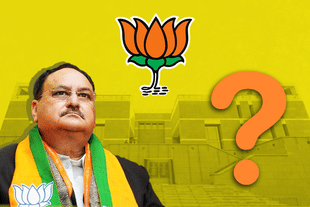News Brief
BJP To Have New National President By Early Next Year As Organisational Elections In Half Of States Set To Conclude Within A Month
Nishtha Anushree
Dec 12, 2024, 04:10 PM | Updated 04:10 PM IST
Save & read from anywhere!
Bookmark stories for easy access on any device or the Swarajya app.


The Bharatiya Janata Party (BJP) is on track to conclude its organisational elections in half of the states by January 15, paving the way for the selection of its new president early next year.
Union Health Minister Jagat Prakash Nadda, who has been serving as the party leader since January 2020, has continued in his role past the end of his term in 2023 due to an extension.
Apart from a few states that went to polls, the membership drive is now being followed by organisational elections at booth, sub-division and district levels and subsequently, state presidents will be elected.
"We should be in a position to wind up elections in half of the states by mid-January. The next step after that will be the election of the BJP national president," a senior BJP leader was quoted as saying by Indian Express.
It is anticipated that the sub-division-level elections will be finalised within the coming five to 10 days. Following this, district elections are scheduled to take place by the year's end or by 5 January, as stated by a party leader.
Despite the current uncertainty regarding the next party president, insiders suggest that an announcement is likely to be made in the early part of next year. The decision will be based on the consensus between the BJP leadership and the RSS.
The BJP central leadership, which seemed somewhat weakened following the Lok Sabha elections, has regained momentum thanks to the outcomes of the Haryana and Maharashtra Assembly elections, and the bypolls in Uttar Pradesh and Rajasthan.
According to the constitution of the BJP, elected presidents at every level, starting from sub-division and district to the state level, appoint a group of office-bearers.
Following the conclusion of elections in half the states, a vote is conducted to select a full-time national president. This newly elected national president then appoints a group of office-bearers.
The party constitution outlines an electoral college process for choosing the national president. However, traditionally, a consensus candidate who submits their nomination papers is "elected" without opposition, rather than the party conducting an actual election.
The position of BJP national president is limited to two consecutive three-year terms, a rule that was established in 2012 when the RSS desired Nitin Gadkari to serve a second consecutive term.
Rajnath Singh, however, stepped in at the last minute to replace Gadkari and remained in the position until the BJP's victory in the 2014 Lok Sabha elections. Amit Shah succeeded Singh as the BJP leader, holding the position until four years ago.
Nishtha Anushree is Senior Sub-editor at Swarajya. She tweets at @nishthaanushree.





